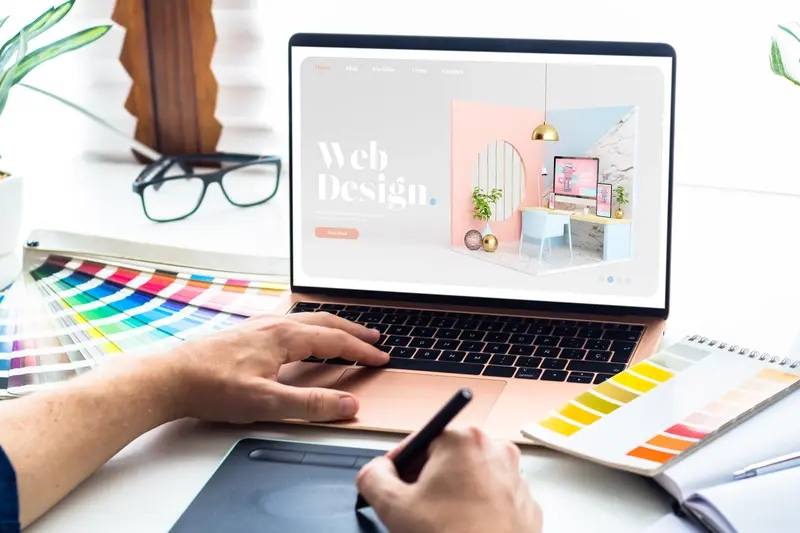Can Good Design Really Make My App More Successful?
It might sound crazy but apps with better design see 5x more downloads than poorly designed ones. That's not just about pretty colours or fancy animations—it's about creating something people actually want to use. And more importantly, something that makes money.
When businesses come to us asking whether design really matters for their mobile app success, I know they're asking the wrong question. It's not whether design matters; it's how much money they're willing to lose by getting it wrong. Poor design doesn't just make apps look bad—it kills downloads, destroys user retention, and sends potential customers straight to competitors.
Good design is actually a lot harder to notice than poor design, in part because good designs fit our needs so well that the design is invisible
But here's the thing: understanding design ROI isn't just about making things look nice. It's about creating experiences that turn browsers into buyers, casual users into loyal customers, and struggling apps into profitable businesses. Throughout this guide, we'll explore exactly how design impacts your bottom line—and more importantly, what you can do about it. Because at the end of the day, every design choice you make either helps or hurts your business success.
What Is Good Design and Why Does It Matter?
Good design isn't just about making things look pretty—though that's part of it. When I'm working with clients, I always explain that good design is about making your app easy to use, understand, and enjoy. It's the difference between someone downloading your app and deleting it after five minutes, or keeping it on their phone for months.
Think about the apps you use most often. I bet they're not the ones with the flashiest graphics or the most complex features. They're probably the ones that just work. The ones where you can find what you need without getting frustrated. That's good design in action.
The Four Pillars of Good App Design
- Usability: Can people actually use your app without getting confused?
- Accessibility: Does your app work for everyone, including people with disabilities?
- Performance: Does it load quickly and run smoothly?
- Visual appeal: Does it look professional and trustworthy?
Here's the thing though—good design directly impacts your bottom line. Apps with poor design see users leave within seconds. That's money down the drain. Meanwhile, well-designed apps keep users engaged, encourage them to spend more time (and money) in your app, and most importantly, they tell their friends about it. Word of mouth is still the best marketing you can get.
How Design Affects User Behaviour and App Downloads
People make split-second decisions about apps—and I mean split-second. Within the first few seconds of seeing your app store listing, users decide whether to download or scroll past. Your icon, screenshots, and description work together to create that first impression. If your design looks outdated or confusing, you've lost them before they've even opened your app.
Once someone downloads your mobile app, UI design continues to shape their behaviour. Clean, intuitive interfaces keep people engaged whilst cluttered screens make them leave. Users expect to understand how to use your app immediately; they won't spend time figuring out complicated navigation or hunting for basic features. Good design guides them naturally through your app without them having to think about it.
Your app icon is your strongest marketing tool—it appears everywhere from search results to home screens. Make it instantly recognisable and avoid cramming too much detail into such a small space.
The Download Decision Process
App store optimisation isn't just about keywords; visual design plays a massive role in conversion rates. Your screenshots need to tell a story about what your app does and why it's valuable. Users scan these images quickly, so highlight your key features clearly. Poor quality visuals suggest poor quality apps, which directly impacts your download numbers and business success.
Design quality signals trust and professionalism—two things that significantly influence whether someone will give your app a chance.
The Connection Between Design and Revenue Growth
Right, let's talk about the bit that really matters—how design actually affects your bottom line. I've worked with clients who've seen their revenue jump by 30% or more just by fixing their app's design. That's not magic; it's good business sense.
When your app looks professional and works smoothly, people trust it more. They're more likely to make purchases, subscribe to services, or upgrade to premium features. Poor design does the opposite—it makes people suspicious and drives them away before they even consider spending money.
How Design Drives Different Revenue Streams
- In-app purchases increase when users can easily find and understand what they're buying
- Subscription rates improve when the value proposition is clear and sign-up process is simple
- Ad revenue grows when users spend more time in your app due to better user experience
- Premium upgrades happen more often when users see clear benefits and smooth upgrade flows
The numbers don't lie. Apps with better design consistently outperform their competitors financially. Users will pay more for an app that feels premium and works well. They'll also stick around longer, which means more opportunities to generate revenue over time.
Design isn't just about making things pretty—it's about creating an experience that makes people want to open their wallets. Every button, every colour choice, every interaction can influence whether someone decides to buy from you or your competitor.
Real Examples of Design Impact on App Success
I've worked with enough apps over the years to know that design changes can make or break a mobile app—and I've got the real-world examples to prove it. Take Airbnb, for instance. Back in the early days, their app was functional but forgettable. When they redesigned it with better photos, cleaner layouts, and smoother booking flows, their bookings shot up by 30%. That's not just good design; that's design ROI you can actually measure.
Then there's Duolingo, which turned language learning into something people actually want to do. Their owl mascot, bright colours, and gamified interface made boring grammar lessons feel like playing a game. The result? Over 500 million downloads and users who come back daily. Compare that to traditional language apps with boring interfaces—most people delete them within a week.
Good design isn't just about making things pretty. It's about making things work so well that people can't imagine using anything else.
Instagram is probably the best example of design driving business success. Their simple, photo-focused design made sharing pictures effortless when other apps were cluttered and confusing. Facebook bought them for $1 billion largely because of how well their design connected with users. That's what happens when design and business goals work together perfectly.
Common Design Mistakes That Hurt App Performance
After years of building apps, I've seen the same design mistakes pop up again and again—and trust me, they can absolutely kill your app's performance. The frustrating thing is that most of these are completely avoidable if you know what to look out for.
One of the biggest culprits is trying to cram too much onto a single screen. I get it, you want to show users everything your app can do, but this approach backfires spectacularly. When users open your app and see dozens of buttons, options, and features staring back at them, they freeze up. They don't know where to start, so they often just close the app instead.
The Most Damaging Design Mistakes
- Overloading screens with too many features and buttons
- Making text too small to read comfortably on mobile devices
- Using colours that don't provide enough contrast for accessibility
- Creating navigation that's confusing or inconsistent between screens
- Ignoring how the app performs on different screen sizes
- Adding unnecessary animations that slow down the user experience
Poor navigation is another performance killer. If users can't figure out how to get from point A to point B in your app, they'll give up quickly. I've seen apps with beautiful graphics that completely fail because users couldn't find basic functions like settings or their profile.
The good news? Once you know these common pitfalls exist, you can design around them from the start and save yourself a lot of headaches later. Understanding why people abandon apps is crucial for avoiding these critical design mistakes.
Measuring Design Success and Return on Investment
Right, let's talk about something that keeps business owners up at night—how do you actually know if your mobile app design is working? I mean, you've spent all this money on making it look good, but how can you tell if it's actually helping your business success?
The good news is that measuring design ROI isn't as complicated as people make it out to be. You just need to track the right things. Start with your app store conversion rate—that's how many people download your app after seeing it in the store. If your icon and screenshots are doing their job, this number should be healthy.
Key Metrics That Actually Matter
Once people have downloaded your app, watch what they do next. User retention is massive here—are people coming back after day one? Day seven? Day thirty? Good design keeps people engaged, which means they stick around longer.
- App store conversion rate (downloads vs views)
- User retention rates (1-day, 7-day, 30-day)
- Time spent in app per session
- Task completion rates
- Customer support ticket volume
- In-app purchase conversion rates
Set up your analytics before you launch—you can't measure improvement if you don't know where you started from.
Calculating Your Design ROI
Here's the formula that actually works: take your increased revenue from improved metrics, subtract your design costs, then divide by your design investment. If your app is generating more money per user because they're staying longer and buying more, that's your design ROI right there.
The beauty of measuring design success is that the numbers don't lie. When users can find what they need quickly and enjoy using your app, they spend more money. It's that simple.
Building a Design Strategy That Supports Business Goals
Here's what I've learned after years of working with businesses of all sizes—your app's design needs to serve your business goals, not the other way around. Too many companies start with what looks pretty rather than what actually works for their bottom line.
Start by writing down your main business objective. Are you trying to get more people to subscribe? Want users to make purchases? Need them to engage with content daily? Your design choices should push people towards these actions, not distract from them.
Making Design Decisions That Drive Results
Every design element should have a job to do. That bright red button isn't just there to look nice—it's there to get people to tap it. The way you organise your screens should guide users naturally towards the actions that matter most to your business.
I always tell clients to think about their user journey like a path through a garden. You want to make the important destinations obvious and easy to reach, whilst removing any obstacles that might make people give up and leave.
Testing Your Strategy
The best design strategy means nothing if you don't test it with real users. Watch how people actually use your app—not how you think they'll use it. Are they finding what they need? Are they completing the actions you want them to? If not, it's time to adjust your approach.
Even seemingly small design elements can have significant impact on user behaviour. For example, understanding how to turn empty states into brand experiences can help maintain user engagement during those moments when content isn't available.
Conclusion
So there you have it—good design absolutely can make your mobile app more successful, and the evidence is pretty overwhelming when you look at the data. I've seen apps transform their business success simply by fixing basic design issues, whilst others have watched their download numbers plummet because they ignored user experience completely.
The connection between design and revenue growth isn't just theory; it's measurable reality. When users can navigate your app easily, find what they need quickly, and actually enjoy using it, they stick around longer and spend more money. They also tell their friends about it, which is the best marketing you can't buy.
But here's the thing—good design doesn't happen by accident. It requires planning, testing, and yes, investment. The design ROI we've discussed throughout this guide shows that money spent on proper design pays for itself many times over. Whether you're launching a new app or trying to fix an existing one, treating design as a core business strategy rather than an afterthought will give you a significant competitive advantage.
The mobile app market is crowded, but users still reward apps that respect their time and make their lives easier. That's your opportunity right there.
Share this
Subscribe To Our Learning Centre
You May Also Like
These Related Guides

How Do I Know When My Design Has Too Much Going On?

Should My App Design Match My Website Design?



